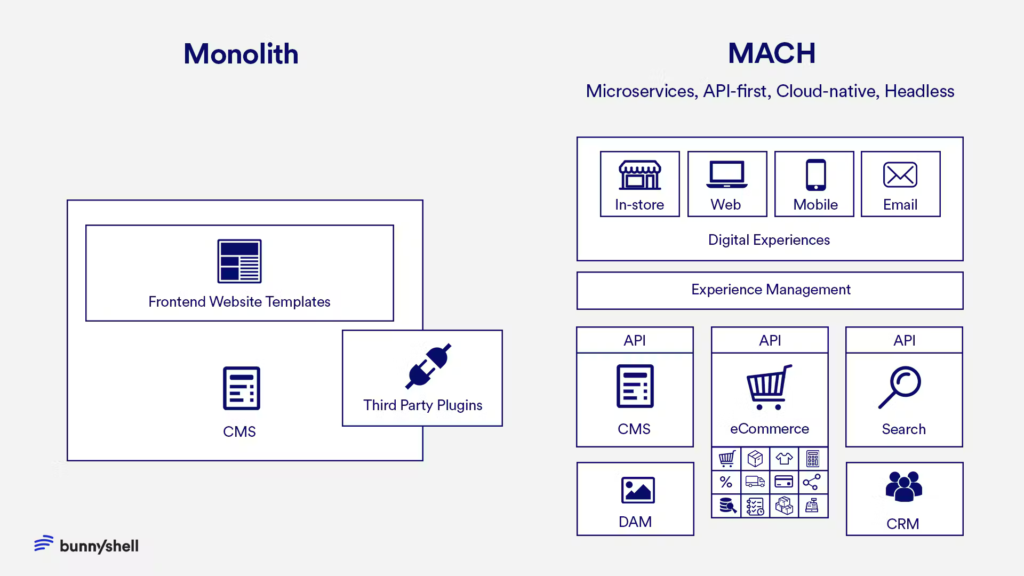Navigating the Digital Evolution
The world of enterprise software is much like a bustling metropolis: always evolving, always on the move. Just when you think you’ve got the lay of the land, a new skyscraper pops up, changing the skyline forever. In this dynamic cityscape of technology, we’ve recently seen some old buildings (read: traditional software systems) showing their age. They’re grand, no doubt, but they’re starting to crumble under the weight of modern demands. It is time for MACH.
Enter MACH: The Modern Architect of Digital Realms
So, what’s the solution when the old structures no longer serve us? We innovate. We adapt. We build anew. That’s where MACH comes into play. Think of MACH as the avant-garde architect, bringing fresh designs to the city of enterprise tech.
Why MACH? Breaking Down the Blueprint
- Microservices: Instead of one massive structure, imagine a series of interconnected, specialized buildings. Each serves a unique purpose, yet they all harmoniously coexist.
- API-first: The bridges and highways connecting these buildings? That’s the API-first approach, ensuring smooth traffic and easy access between functionalities.
- Cloud-native SaaS: Modern buildings need modern utilities. Cloud-native SaaS ensures that our tech infrastructure is not just about storage or hosting; it’s about dynamic scaling, resilience, and always being up-to-date.
Headless: In our city analogy, this would be like having the freedom to redesign the facade of a building without affecting its foundation. Front-end (the facade) is decoupled from the back-end (the foundation), allowing for unparalleled flexibility.
A Quick Glance: Traditional vs. MACH
| Aspect | Traditional Systems | MACH Approach |
|---|---|---|
| Structure | Monolithic | Microservices |
| Integration | Rigid | API-first |
| Infrastructure | Static Hosting | Cloud-native SaaS |
| Flexibility | Limited | Headless Design |
In essence, MACH isn’t just a buzzword; it’s a response. A response to the limitations we’ve felt with monolithic systems and a beacon guiding us toward a more agile, adaptable, and efficient digital future. So, as we stroll through this tech metropolis, let’s explore the MACH marvels that are reshaping our skyline.
Breaking Down MACH

Microservices: The Modular Maestros of Modern Tech
From Monoliths to Modules: A Tale of Transformation
Remember those old-school LEGO sets? The ones where you had a single, massive piece that was supposed to be the centerpiece? That’s a bit like the monolithic architecture of yesteryears. Impressive, sure, but not very flexible. If you wanted to change something, you’d have to dismantle the whole thing and start from scratch. Quite the hassle, right?
Now, imagine a LEGO set where each piece is distinct, specialized, and can be connected in any way you like. Want to swap out a section? Easy peasy. That’s the magic of Microservices. Instead of one behemoth system, you’ve got a collection of smaller, specialized services that work together in harmony.
The Perks of Going Micro:
- Scalability: Just like adding more LEGO pieces to your masterpiece, with microservices, you can scale up specific parts of your application without overhauling the entire system.
- Flexibility: Fancy a change? No need to reinvent the wheel. Adjust, adapt, and evolve individual services as needed.
Faster Time-to-Market: With smaller components to manage, testing and deploying become a breeze. This means you can roll out new features or updates in a jiffy.
Monolithic vs. Microservices: At a Glance
| Feature | Monolithic Systems | Microservices |
|---|---|---|
| Size | Large & Cumbersome | Small & Specialized |
| Deployment | All-at-Once | Individual Services |
| Flexibility | Rigid | Highly Adaptable |
| Scalability | Limited | Specific Components |
| Development Speed | Slower | Rapid & Efficient |
In the grand tapestry of modern tech, microservices are like intricate threads, each with its own color and texture, weaving together to create a stunning picture. They’re the unsung heroes, working behind the scenes, ensuring that our digital experiences are seamless, efficient, and oh-so-smooth. So, next time you marvel at a slick app or a lightning-fast website, tip your hat to the mighty microservices, the modular maestros of the MACH ensemble.
API-first: The Digital Diplomats of the Tech World
The Ascendancy of API-centric Architectures
Picture this: You’re at a bustling international airport, and there’s a flurry of activity. Flights are coming in and out, people from all over the world are connecting, and everything seems to be in motion. But have you ever wondered how it all works so seamlessly? Enter the unsung heroes: the translators, ensuring everyone understands each other and making connections smoothly and efficiently. In the tech realm, these translators are known as APIs.
APIs, or Application Programming Interfaces, have taken center stage in recent years. Gone are the days when software systems were isolated islands. Today, it’s all about collaboration, integration, and communication. And that’s where an API-centric, or API-first, approach shines. It’s all about designing APIs right from the get-go, ensuring that different software components can chat, mingle, and work together in harmony.
Why API-first? The Gains of Going API-centric:
- Interoperability: Just like our trusty translators at the airport, APIs ensure different systems, apps, and platforms understand each other. It’s all about making sure everyone’s speaking the same language.
- Integration Ease: Think of APIs as the connectors, the bridges between different software realms. They make sure data flows smoothly, integrations are a breeze, and everything just… clicks.
Modular Development: With an API-first approach, development becomes a modular affair. Build once, use everywhere. It’s like having a universal adapter when you travel; it just fits no matter where you are.
Traditional vs. API-first Approach: A Quick Dive
| Aspect | Traditional Approach | API-first Approach |
|---|---|---|
| Design Focus | After Development | Before Development |
| Integration | Often Cumbersome | Seamless & Smooth |
| Scalability | Limited | Highly Scalable |
| Development Speed | Variable | Faster & Efficient |
In the ever-evolving tech landscape, APIs are the diplomats, ensuring peace, harmony, and collaboration. They’re the bridges connecting different software kingdoms, making sure data, functionalities, and services flow without a hitch. So, as we journey through the MACH universe, let’s give a nod to the API-first approach, the strategy that ensures everyone, and everything, is in sync.
Cloud-native SaaS: Soaring Beyond the Traditional Cloudscape
Beyond Basic Clouds: The New Horizon of Cloud-native SaaS
Imagine you’ve always lived in a cozy ground-floor apartment. It’s comfortable, but your view is limited to the street outside. One day, you decide to move to a penthouse on the 50th floor. Suddenly, the world looks different. You see horizons you never knew existed. That’s the leap from traditional cloud usage to Cloud-native SaaS. It’s not just about being in the cloud; it’s about maximizing its potential, embracing its vastness, and truly living in the sky.
Cloud-native SaaS isn’t just another tech buzzword. It represents a paradigm shift in how we approach cloud computing. Instead of merely using the cloud as a storage locker or a hosting platform, cloud-native applications are designed from the ground up to thrive in a cloud environment.
The Silver Linings of Cloud-native SaaS:
- Elastic Scaling: Much like a balloon that can expand or contract based on the air inside, cloud-native applications can scale up or down based on demand. Peak traffic hours? No sweat. The system scales up. Quiet night? It scales down. Effortlessly and efficiently.
- Resilience: In our penthouse analogy, think of this as having multiple backup generators. If one fails, others kick in. Cloud-native SaaS is designed for high availability, ensuring minimal downtime and disruptions.
Cost-Effectiveness: Remember the days of buying, maintaining, and upgrading physical servers? With cloud-native, you pay for what you use, and there’s no hardware fuss. It’s like having a maintenance-free penthouse with all the amenities.
Traditional Cloud vs. Cloud-native SaaS: A Bird’s Eye View
| Feature | Traditional Cloud | Cloud-native SaaS |
|---|---|---|
| Design Philosophy | Cloud as an Add-on | Cloud at the Core |
| Scalability | Manual & Limited | Dynamic & Elastic |
| Resilience | Variable | High & Robust |
| Cost Model | Fixed Infrastructure | Pay-as-you-go |
In the grand symphony of the digital age, Cloud-native SaaS is the crescendo, the high note that resonates with possibilities and potential. It’s the promise of a future where applications are not just in the cloud but are of the cloud, harnessing its full power and promise. So, as we navigate the MACH skies, let’s appreciate the vast expanse of Cloud-native SaaS, the realm where software truly takes flight.
Headless: The Game-Changer in the Digital Design World
The Decoupling Revolution: A Tale of Two Halves
Imagine you’ve got this super cool toy robot. It’s got flashy lights, makes quirky sounds, and even dances. But what if you could swap its head with another robot to give it a fresh look without affecting its dance moves? That’s the essence of headless design in the tech realm. It’s about separating the ‘head’ (the front-end or user interface) from the ‘body’ (the back-end or core functionality). This decoupling means you can change how things look and feel without messing with how they work.
The headless approach is like the fashion-forward trendsetter in the software design world. It’s not just about aesthetics; it’s about agility, adaptability, and staying ahead of the curve.
Why Go Headless? The Perks of Decoupling:
- Flexibility in Front-end Development: Just like swapping out robot heads with headless design, you can revamp, redesign, or rebrand the user interface without diving deep into the back-end code. It’s all about freedom and flexibility.
- Multi-channel Consistency: In today’s digital age, users interact with brands across various devices and platforms. From mobile apps to smartwatches, from websites to voice assistants, headless ensures a consistent user experience everywhere. It’s like having your robot dance the same way, whether it’s on a stage, in a park, or on a beach.
Faster UI Iterations: With the front-end decoupled, designers and developers can iterate, test, and deploy UI changes at lightning speed. It’s about staying nimble, agile, and always being runway-ready.
Traditional vs. Headless Design: A Snapshot
| Aspect | Traditional Design | Headless Design |
|---|---|---|
| Development Focus | Combined UI & Logic | Separate UI & Logic |
| UI Flexibility | Limited | High |
| Multi-channel Support | Often Restrictive | Seamless & Consistent |
| UI Update Speed | Slower | Rapid & Streamlined |
In the vibrant tapestry of the MACH universe, headless design is like the bold, standout pattern that catches your eye. It’s the approach that says, “Why be confined by conventions when you can redefine them?” As we continue our MACH journey, let’s celebrate headless, the approach that’s reimagining the boundaries of design and development, one decoupled step at a time.
Best MACH solutions in the market
Kontent.ai:
A platform emphasizing the importance of MACH in delivering engaging digital experiences. Kontent.ai offers solutions leveraging MACH principles, especially in content management.
Akeneo:
Focuses on incorporating brand values into messaging. Stresses the importance of aligning personal values with brand values, especially in sustainability and ethical practices.
Conscia.ai:
An Experience Orchestration platform enabling marketers to compose intelligent experiences across all channels in a composable stack.
Mercaux:
Highlights the importance of composable architecture for retailers. Enhances the in-store experience, such as Clienteling and Distributed OMS.
Sitoo:
A cloud-native Unified Commerce platform anchored by POS. Emphasizes unifying data and sales channels for a seamless real-time cross-channel shopping experience.
Talon.One:
Focuses on delivering personalized customer experiences using promotional solutions. Sees promotions as essential for omnichannel customer engagement.
Uniform:
Offers solutions focusing on Digital Experience Composition. Emphasizes the importance of composable and embeddable user interfaces from headless vendors.
Vue Storefront:
Emphasizes the shift to a multi-channel, customer-centric, front-end first approach. Highlights the importance of the customer experience and its impact on conversion.
Bunnyshell:
A cloud automation and orchestration platform simplifying application deployment, management, and scaling. Integrates cloud-native technologies for optimal performance and scalability.
Conclusion
As we’ve strolled through the bustling streets of the MACH metropolis, we’ve marveled at its architectural wonders. From the modular maestros of Microservices to the diplomatic prowess of API-first designs, from the soaring skyscrapers of Cloud-native SaaS to the fashion-forward trendsetters of Headless design, it’s clear: MACH isn’t just a tech acronym; it’s a vision of the future.
Why All the Buzz About MACH?
It’s not just about the cool tech jargon or the innovative approaches. It’s about reimagining how we build, design, and experience the digital world. It’s about breaking free from the constraints of the past and embracing a future that’s flexible, scalable, and oh-so-exciting.
What’s Next on Our MACH Adventure?
But, as they say, the best is yet to come! While we’ve explored the ‘what’ of MACH, it’s time to delve into the ‘why’. Why is the business world all abuzz about MACH? Why are modern enterprises betting big on this approach? And most importantly, why should you, dear reader, sit up and take notice?
Coming Up: The MACH Impact on Modern Businesses
So, grab your explorer’s hat and your sense of wonder. As we venture into the next section, I’ll uncover the reasons Why MACH Matters for Modern Businesses. Trust me; you won’t want to miss this!

